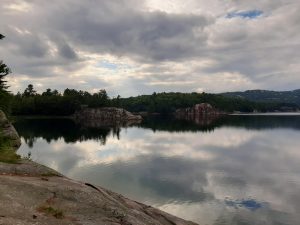
The following is the transcript from our podcast episode called Experience Nature While Camping. If you prefer to listen to it, you can listen here.
Pamela: Hello, and good day, eh? Welcome to the Super Good Camping podcast. My name is Pamela
Thomas: I’m Thomas.
Tim: And I’m Tim.
Pamela: And we’re from SuperGoodCamping.com. We’re on a mission to inspire other families to enjoy camping adventures, such as we have with our kids. Today want to talk about a few things mostly related to our experience of nature while we’ve been camping. And so I’ll toss it over to Tim.
Plants, Animals, and Landscape While Camping
Tim: Okay, the first thing I would say is, that one of the amazing things about camping is being in touch with nature. I was gonna say being one with nature, but that involves meditating and stuff. We like to involve ourselves in nature, so it’s sort of a three-pointer for me. There are plants, there are animals, and then there’s the landscape – things like waterfalls. We love waterfalls.
Pamela: We play in them at Arrowhead, at Stubb’s Falls.
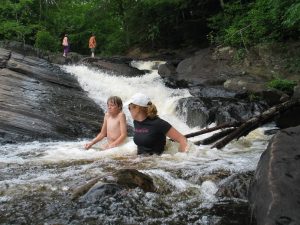
Tim: Thomas and I have run into a surprising number of waterfalls on our backcountry trips. The boys and I ran into just a little burbling but very cute waterfall, on our incredibly short portage last fall, when we went to Kawartha Highlands. We’re touring along doing a portage and “say, what’s that I hear? Running water?” Okay, so we plunk everything down and go in and check it out. I know that Jeff from Unlostify loves to put stuff like that on his maps. If you’re paying attention when you’re reading the map, you can see that, oh, there’s a little waterfall over there that nobody knows about. It’s a little off the beaten path. We like doing things like that. But I love checking out animals and having encounters with them. Positive encounters, that is. Plants, I’m not so good at. I know trees and stuff. I know what poison ivy looks like. Here’s a perfect segue. Books, get books. Read books. Learn where to go to see the things and where to not step to avoid the poison ivy. Poison ivy is not a fun thing to get into. Learning about plants or animals doesn’t have to be from books. It can be a YouTube channel. I’m sure I sound like a fanboy, but Kevin Callan knows all kinds of stuff and he’s great at knowing plants. He has some amazing videos. He is KC Happy Camper on YouTube. But you can go to a Mountain Equipment Co-op, a Canadian outdoor equipment company, and pick up books on edible wild plants and mushrooms, which Pamela’s a huge fan of!
Pamela: There are these amazing mushrooms at Killarney Provincial Park. We were there last summer. We have so many pictures. I’ll put some on the website.
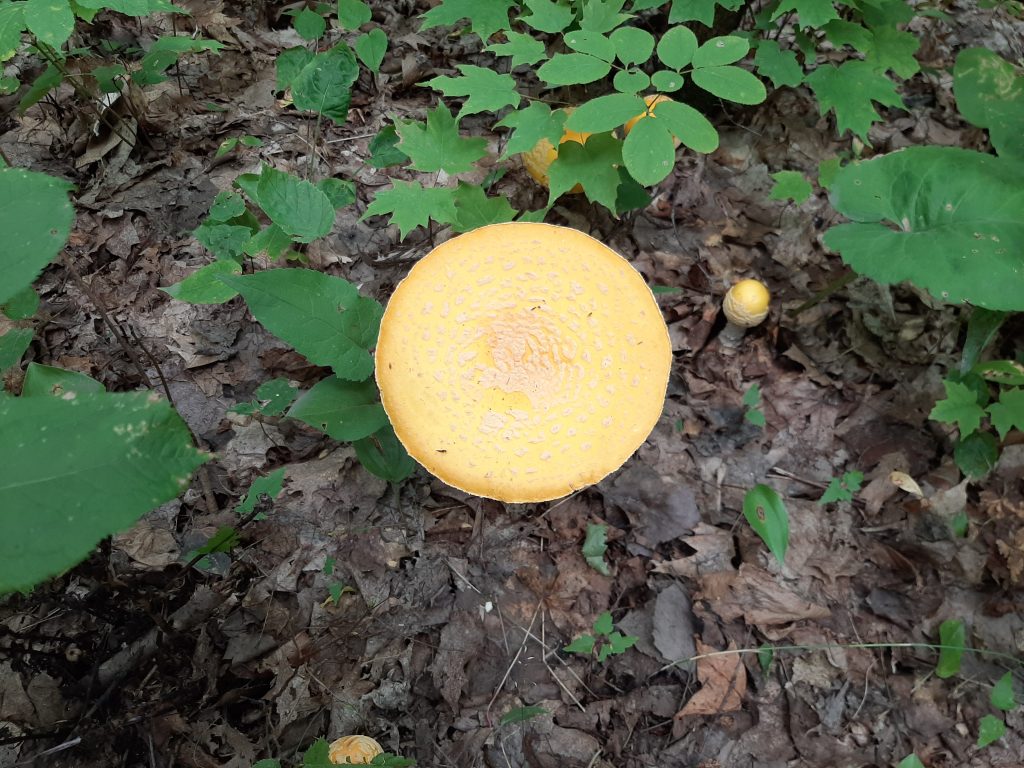
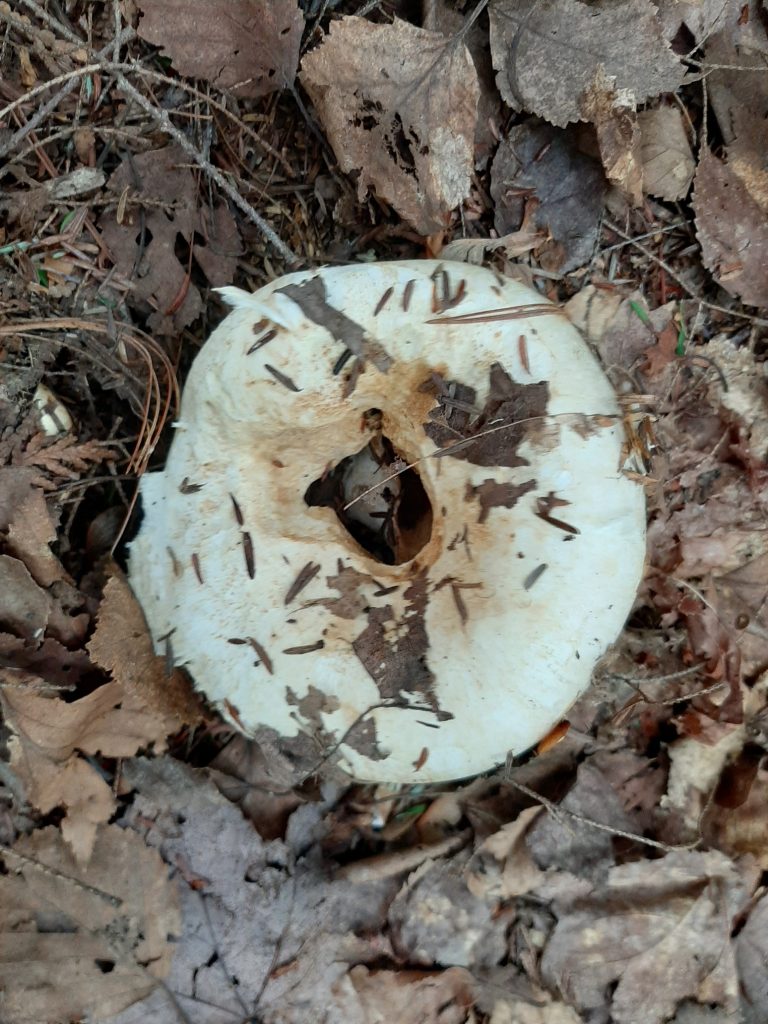
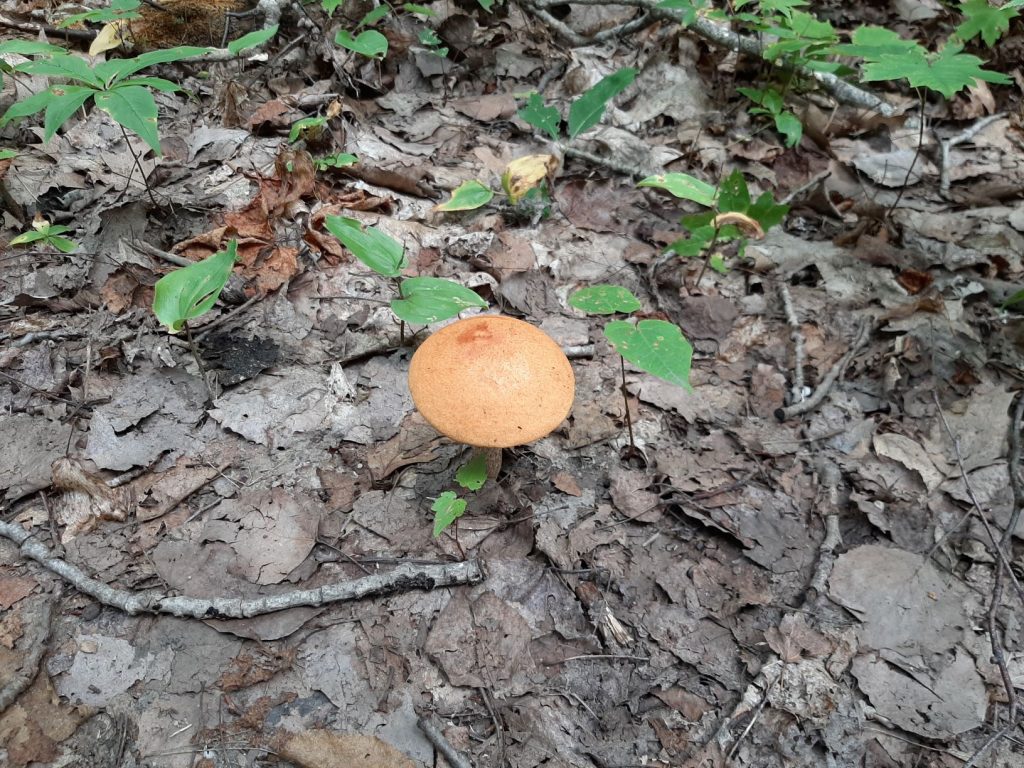
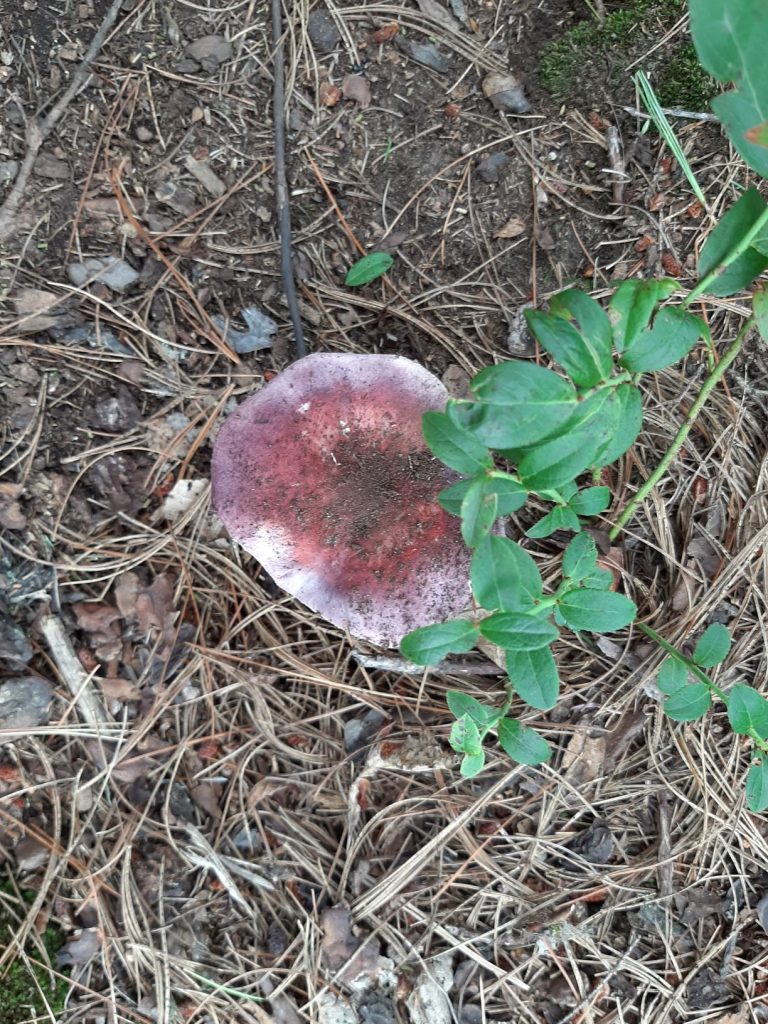
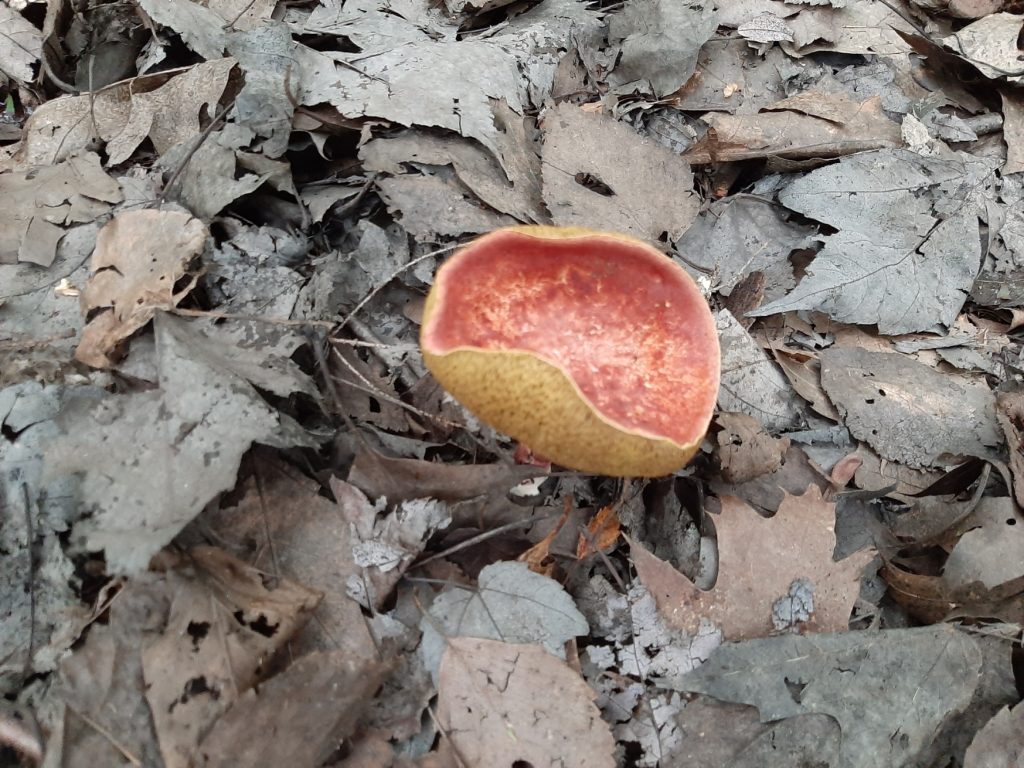
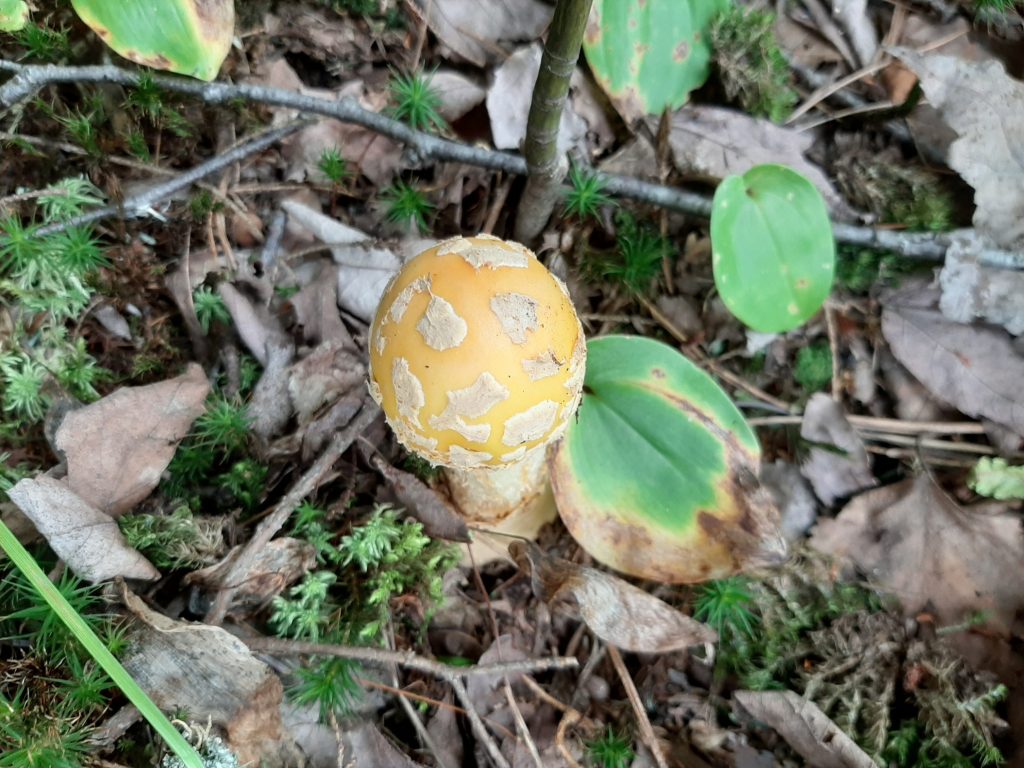
Tim: Very, very cool ones too. One that looks like a bagel on the ground. Excellent stuff. And we have eaten wild mushrooms…
Pamela: Don’t do that, unless you’re absolutely sure that you know what you’re doing.
Tim: I checked with a guy that knew.
Pamela: Oh, that guy.
Tim: We ate them in our old apartment. Plants of Southern Ontario is another book. It’s got all kinds of stuff in it. They’re full-on books. But there are also compact books that you can take with you – just saying. They’re obviously priced quite a bit differently and they have less information. But if it’s in your back pocket and you go “Oh, what is that? You can flip through and check that out. Knowing your trees is a good thing to know whether it’s a Silver Birch or oak or different types of maples, whether it’s an invasive species, that sort of thing. And then we get into animals and I’m going to let Thomas mention some of the animals we’ve come across in our many years of camping, we’ve seen tons.
Thomas:
We’ve seen lots and lots and lots and lots of frogs. Specifically, one site just had tonnes and tonnes, like the ground was just covered in these teeny, tiny frogs. You could probably fit two on a dime. And we could hear, we didn’t see any, but we could hear bullfrogs across the lake. We’ve seen things like skinks.
Tim: A five-lined skink. We saw a juvenile and what’s the giveaway on a five-lined skink?
Thomas: Five lines?
Tim: It had a blue tail. Have you ever seen a blue amphibian before? That was very cool.
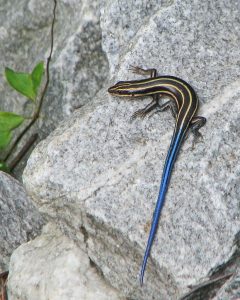
Pamela: It’s the only lizard native to Ontario.
Thomas: We’ve seen lots of different birds. We’ve seen hawks. We’ve seen falcons, herons…
Tim: I believe, herons and cranes. What was the big bird that sort of blew us away? We didn’t actually realize that we had them here.
Thomas: When we were in Algonquin.
Pamela: You could answer your own question.
Tim: It’s viewed as an American bird,
Thomas: Ah, a bald eagle.
Tim: We’ve got a winner. We saw that in Algonquin Park a few years back. Bears, moose. I have at least two pictures of Thomas with moose in the background.
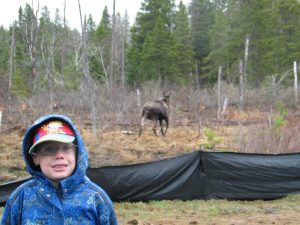
Tim: I don’t think we’ve seen wolves, but we’ve heard them. Weirdly, we’ve seen coyotes here in Midtown Toronto. Not out in the wilderness.
Pamela: Lots of coyotes in Midtown Toronto.
Tim: Yeah, that and raccoons. I can say I’ve never had a positive experience with a raccoon. Whether they’re in my garbage pails here in Midtown Toronto, or they’ve eaten through our dry bag or Seal bag. It was garbage afterward. They were trying to get at our food. We were trying to use a dry bag as a food bag. We’ve changed that up now. We use a polyethylene bucket, not the barrels that everybody uses. We use a Home Depot pail.
Thomas: We now have a new lid for that which screws on instead of having to snap it on.
Tim: Far more convenient, should be cool. Hopefully quieter. And where was it, was it at Bon Echo where the raccoons got into my coffee sugar cubes?
Pamela: Yes, it was the middle of the night and we woke up to: “crunch, crunch, crunch, crunch” and repeatedly too. Every time you chased them away and went back to bed, then they’re right back at it.
Tim: Yeah, poopyheads! It was brutal. And of course when does that stuff happen? Three o’clock in the morning. Blue Jays are amazing because they hang around a little bit more when you’re out in nature. Squirrels…
Pamela: We’ve seen deer, families of foxes, lots of chipmunks. What else have we seen? Possums? I’m not sure if we’ve seen possums. I’ve seen possums here in Midtown Toronto. Beavers?
Tim: Oh, yeah, yeah, we’ve seen beaver dams. I don’t know if we saw the beaver. We’ve seen otters and I’m pretty sure we’ve seen muskrats. They are a weaselly version of an otter. A porcupine.
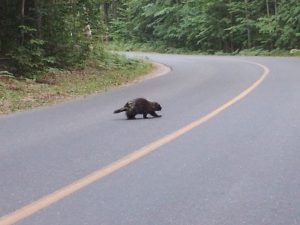
Pamela: Rabbits.
Tim: Plenty of rabbits. We’ve actually had, again, here in Midtown Toronto, we had a small family. What do you call them? Is it a coven? Or is that witches? [Editor’s note: a group of rabbits is appropriately called a fluffle. A rabbit’s home is called a warren. This is where I think Tim was going]. There was a depression on our front lawn, and I was mowing the lawn. And I saw a little puff of hair. And it didn’t go together in my mind at first. What? Wait a minute, and I went back and I can see some hair. And I got looking and it was five itty, bitty baby rabbits. Thankfully the hair was just loose fur. I didn’t cut any fur off of any of them. So I quit cutting that part of the lawn for a few weeks. And poof, baby rabbits. It was very cool.
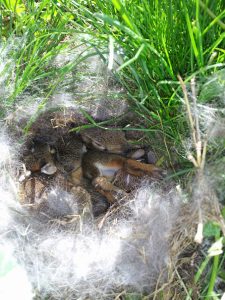
Tim: Okay, so yeah, I would recommend getting books. Learn, learn yourself, do some learnin’. And part of that, for sure is learning where to go and where not to go. This leads me to when I say where not to I mean, don’t step into poison ivy. Don’t step in the poison oak. I’ve seen some pretty big horror stories. We have some books: Paddling and Hiking Ontario Southern Shield Country, Ontario Provincial Parks Trail Guide, and Waterfalls of Ontario. I like this one because I just have a thing for waterfalls, but it gives you trails to go and check out. It puts you in the right place. You can just wander off whether it’s from your front country or backcountry site and go check things out. By all means, I highly recommend it. One of the neat things that we, Thomas and I, found our first year at Kawartha was that we wandered way back into the site and discovered that most of the sites are connected by a series of ATV trails. We used that to wander off and do some exploring like a hiking path. It was well grown over. It’s not heavily used. I’m sure that they just come in to make sure that everything’s copacetic once in a while, replace picnic tables and amenities. But yeah, it got us into different places that we might not have been able to get to. When you’re in a canoe, it’s a very different sort of thing. You’re not quite shorebound, but you have limited access farther back into the bush. That was a nice way for us to get farther back. And with that said, that’s books, that’s animals, plants, water features. When we go out and do these things, we like to capture them or, at the very least, have a better viewing experience. So we’ve got a set of binoculars. It’s just a crappy set from a Canadian Tire sale, but we didn’t have a pair up to that point. I want to say I probably paid 70 bucks, maybe for something that was worth triple that. They’re Bushmaster 7×35. You can zoom the crap out of things far, far away, which is great, especially if you get to see a bald eagle sitting on top of a tree somewhere. And then we take lots of pictures and shoot a lot of videos or at least I do. The easiest thing is your phone. Phones have incredible cameras in them now and they’re in your pocket most of the time. So that is dead easy, right? You can also use all those wonderful Google things that you can search up “what was that that I just looked at?” Was that a duck or a loon or a cormorant?
Thomas: Just a quick note on that, Google Lens is an app that I have and that I use often, certainly when I have access to the Internet. When I don’t know what something is, I point my camera at it, open the app, and just about every time it can tell me exactly what the thing is that I’m looking at.
Pamela: I’ve used Google Lens too, it is really awesome. We did a little review for our Beaver Scouts of wildflowers. So I took a little walk in the woods and just used Google Lens to identify some of the wildflowers that I saw. So it’s perfect.
Tim: And there’s another nod to Kevin Callan, part of that Beavers meeting used one of his videos.
Pamela: We used his wildflower video on YouTube and it was great too because it was local. It was helpful for them to be able to see specific wildflowers. Right now we’re having to do virtual scouting. We need some resources like Kevin Callan videos to be able to try to teach them some things that we otherwise would walk around in the woods and show them.
Camera Equipment for Camping
Tim: Yeah, I guess he does 50-60 days a year out and about on the water. He’s been doing it forever and he’s a teacher so he knows all those things. Plus, he also lives with wood lots in his backyard, not quite, but very, very, very close to them. There are binocular cameras on your phone, for sure, but I have SLRs and stuff too. They’re a bit of a different deal. I take a Panasonic Lumix DMC-ZS60. It’s a point-and-shoot. It does almost everything. If there was one thing that I would like it to do, it would be to have a detachable screen or a screen that you can pivot and turn so that you can see from a different angle. But it’s got 30 times optical zoom, so massive zoom shoots. Great video. It has pretty good gyro stabilization on it. It takes fantastic pictures, I love the color. I’m a big Canon fan period. It tends to be warmer colored than the Nikon’s. Nothing against Nikon just saying they’re a little cooler, a little crisper, and a little more towards the blue end of the spectrum. The Panasonic is probably my favorite all-around camera. For backcountry, Thomas and I also tend to take an SJ Cam. It’s a Chinese knockoff of GoPro. It’s basic. I would say it’s rugged, it’s been through some bangs and clangs. We do have a protective housing on it but it’s done some good service. We’ve shot all kinds of good videos on it. We have also shot all kinds of really crappy videos on it where I wasn’t bright enough to set up the settings properly but it’s pretty bomb-proof. It does do a good job. It records decent sound. It does what you want it to do and not much else but that’s okay. This year, I picked up a Campark V30. It’s got a touchscreen on it which is quite nice. It will shoot up to 4k. I don’t have anything that displays 4k. So I can’t tell you if it does a better job or not. I would say the picture is around the same as the SJ Cam. Looking at the two of them the Campark V30 might be a little bit crisper. The sound on the camera itself is crappy. It’s mud. And I don’t know if it’s specific to this camera or if I just got a lemon. We tried to get it sorted out with them. They were very, very helpful, but it still sounds like crap. So I picked up a lav mic in the hopes that it helps somewhat.
Thomas: I would like to quickly point out that my father is a bit of an audio freak. So his senses may be a little more attuned, slightly more sensitive than the average person’s
Tim: And I have ancient ears that have been to a number of very loud concerts and have listened to far too many explosions in my previous job as a special effects guy. And lastly, we have an actual video camera not a full-on but it’s a Canon Vixia. It’s got a pivoting screen and I’ve got a boom mic for it. It has 32 times optical zoom on it. So again, I can do some pretty incredible stuff with it. And I’m hoping to put all that package together and actually do some decent videos this year for both the website and our YouTube channel. And I’m sure we’ll do a more involved camera thing at some point where I talk about power packs and solar chargers and all the wonderful toys it needs to go along with it.
Thomas: The electronics kit
Tim: We take a pile of stuff. Yeah. It doesn’t make for a light trip and especially when you’re doing backcountry but you know what…
Thomas: It’s worth the weight. It’s worth the memories.
Tim: For sure that and that’s exactly it. Thomas has hit the nail on the head there. We have a smart screen in the kitchen, and I spend a surprising amount of time in the kitchen. I like that smart screen simply because I watch memories go by. It does random pictures. I get to look at him when he was 11 and he had some kind of Gecko thing in his hands, right? And I look at his dirty nails because they were digging in the dirt. And I think that’s just such an awesome thing.
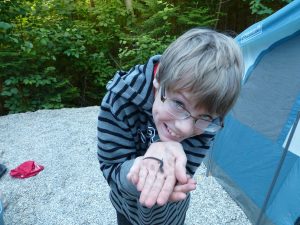
Thomas: It brings up memories that you otherwise wouldn’t have thought about.
Tim: And it’s not just camping, there’s the cottage, it’s all those wonderful memories.
Thomas: I see photos of me on there that I don’t remember being there for.
Tim: He’s six foot two now, there are pictures from back when he was three foot four.
Thomas: Yeah, so bring all the electronics all the heavy camera equipment. It’s worth the memories that I will get to see when I have kids of my own and I’m going back to when I was your age.
Tim: Don’t lose your mind over it.
Thomas: Do bring something that can snap a few shots, that can get a few videos, even if it’s just your phone. It’s better than not having any of the memories later.
Pamela: And it goes by fast parents, got to create those memories now.
Tim: They’re what, how old now? I can’t tell you how often that comes up in conversations.
Pamela: I think that’s it for us for today. Thanks for listening, and we’ll try to put out new podcasts regularly. My name is Pamela
Thomas: I’m Thomas.
Tim: I’m still Tim
Pamela: And we’re from SuperGoodCamping.com. Please do reach out to us by email. Our email address is hi@supergoodcamping.com. Thanks. Talk to you soon.
Tim: Bye.
